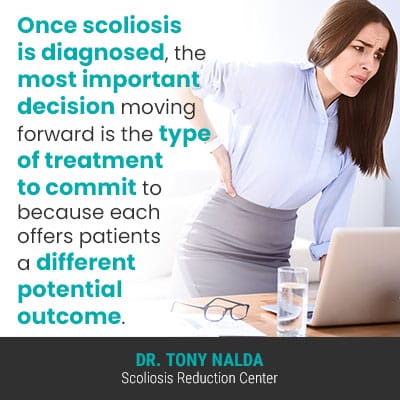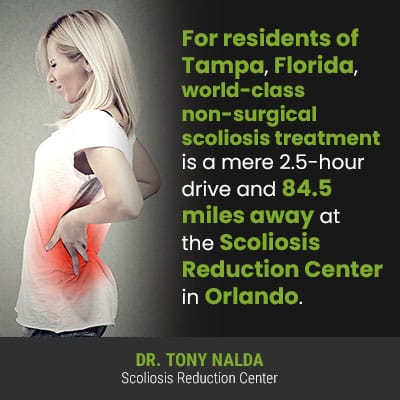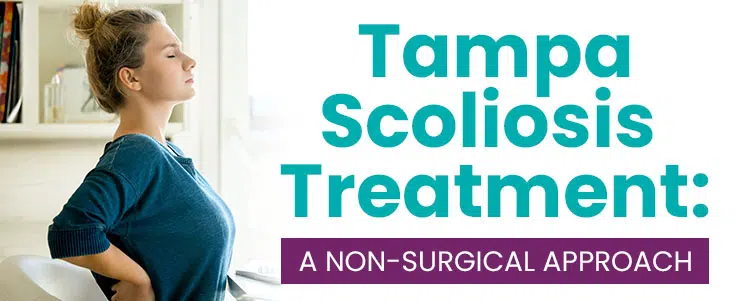Scoliosis can be a confusing condition to be diagnosed with, but choosing the right treatment provider can help by providing continued support and guidance. The complex nature of scoliosis necessitates a customized approach, which is why committing to a scoliosis chiropractor trained in multiple treatment modalities, can help increase treatment efficacy.
For those in search of Tampa scoliosis treatment, one of the world’s leading scoliosis chiropractors is 84.5 miles and a 2.5-hour drive away. Patients of the Scoliosis Reduction Center® in Orlando have the advantage of accessing multiple forms of treatment, and the benefits of each, under one roof.
Let’s start our discussion of Tampa’s scoliosis treatment by first addressing some specifics of the condition itself.
Looking for another city in Florida for scoliosis treatment?
- Daytona Beach Area Scoliosis Treatment
- Sarasota Area Scoliosis Treatment
- Fort Lauderdale Scoliosis Treatment
- Tallahassee Scoliosis Treatment
- Orlando Scoliosis Treatment
- Miami Scoliosis Treatment
- Jacksonville Scoliosis Treatment
- Pensacola Area Scoliosis Treatment
Why Scoliosis is Considered Complex
Scoliosis is a structural spinal condition that involves the development of an unnatural sideways spinal curve with rotation, and a minimum Cobb angle measurement of 10 degrees.
Scoliosis introduces a lot of uneven forces to the body, and it’s the rotational component that makes it a 3-dimensional condition; the spine doesn’t just bend unnaturally to the side but also twists from front to back, back to front.
The Cobb angle is a measurement taken during an X-ray that classifies conditions as mild, moderate, severe, or very severe:
- Mild scoliosis: Cobb angle measurement of between 10 and 25 degrees
- Moderate scoliosis: Cobb angle measurement of between 25 and 40 degrees
- Severe scoliosis: Cobb angle measurement of 40+ degrees
- Very-severe scoliosis: Cobb angle measurement of 80+ degrees
As you can see from the wide range of Cobb-angle measurements, scoliosis is also highly variable, which is why there is no one-size-fits-all approach to scoliosis treatment, and why each and every treatment plan has to be customized to address specific patient and condition variables.
In addition, scoliosis is progressive, meaning it’s in its nature to worsen over time, particularly if left untreated or not treated proactively, which is why residents of Tampa, Florida, are at such an advantage when it comes to effective scoliosis treatment: being only 84.5 miles, and a 2.5-hour drive, away from world-class non-surgical scoliosis treatment at the Celebration, Orlando Scoliosis Reduction Center®.
There are two main scoliosis treatment approaches for patients to choose from: traditional and conservative.
Traditional Scoliosis Treatment
Scoliosis has been around for hundreds of years, as has the traditional approach to scoliosis treatment, but despite our evolving understanding of the condition and how it responds to treatment, the approach has changed little over those years.

Once scoliosis is diagnosed, the most important decision moving forward is the type of treatment to commit to because each offers patients a different potential outcome.
The traditional approach funnels patients towards spinal fusion surgery with a more reactive than a proactive response to a scoliosis diagnosis.
Patients with mild scoliosis are told solely to monitor for progression by watching and waiting.
Depending on the treatment provider, patients are told to return at periodic intervals to be reassessed every 3, 6, and even 12 months.
The issue I have with this is that as a progressive condition, we know that virtually every patient’s condition is going to worsen at some point, so why not be proactive and start treatment as early as possible, particularly as it’s simpler to treat scoliosis while mild.
When scoliosis is mild, the curve is small, more flexible/responsive to treatment, and the body hasn’t yet had time to adjust to the unnatural spinal curve’s presence.
In addition, adolescent idiopathic scoliosis is the most prevalent form, diagnosed between the ages of 10 and 18, and as growth and development are the number-one triggers for progression, this age group is at risk for rapid-phase progression.
If an adolescent has a significant growth spurt in between assessments, as they are known to do during the stage of puberty, their scoliotic curve is also likely to increase significantly in size.
The only form of treatment the traditional approach applies prior to a surgical recommendation is traditional bracing, and there are a number of shortfalls associated with the most commonly used traditional brace: the Boston brace.
If a patient still shows signs of progression and crosses into the severe and very-severe classification at 40- and 80-plus degrees, they become a candidate for spinal fusion, which is a costly, lengthy, and invasive procedure with serious potential significant risks and side effects.
For those who choose to forgo a surgical recommendation or simply want to try a safer, less-invasive treatment option first, Dr. Tony Nalda is located in Celebration, Orlando, where he has been providing patients with premium nonsurgical scoliosis treatment for 20+ years.
Conservative Non-Surgical Scoliosis Treatment

For residents of Tampa, Florida, world-class non-surgical scoliosis treatment is a mere 2.5-hour drive and 84.5 miles away at the Scoliosis Reduction Center® in Orlando.
I take a conservative treatment approach, which means I strive to preserve as much of the spine’s natural function as possible. I do this by being proactive with treatment and starting it as close to the time of diagnosis as possible.
I don’t sit back and watch while a young patient’s condition progresses because that’s wasting valuable treatment time; instead, I craft customized treatment plans that address the condition’s 3-dimensional nature by impacting it on multiple levels.
As I’m trained and certified in multiple scoliosis-specific treatment forms, patients of the Center have the advantage of accessing the benefits of varying types of treatment under one roof.
I integrate chiropractic care, in-office therapy, custom-prescribed home exercises, and corrective bracing (known to address many of the shortfalls associated with traditional bracing).
First and foremost, as scoliosis is structural, I work towards impacting scoliosis on a structural level, and once I see those results, I shift the focus to increasing core strength, so the spine is optimally supported/stabilized by its surrounding muscles.
Through chiropractic care, I can manually adjust the position of the most-affected vertebrae back into alignment with the rest of the spine, and through a variety of therapies and scoliosis-specific exercises (SSEs), the spine and core muscles can be strengthened.
In addition, SSEs can activate certain areas of the brain for improved brain-body communication, postural remodeling, and a more natural body positioning.
While there are no treatment guarantees, being proactive means potentially helping patients prevent progression, increasing condition severity, escalating symptoms, and the need for more invasive treatment in the future.
Those in the Tampa, Fl area in search of non-surgical scoliosis treatment, look no further than the Scoliosis Reduction Center®’s Dr. Tony Nalda: CLEAR-certified scoliosis chiropractor.
Conclusion
While people travel from far and wide to access the industry-leading quality of non-surgical scoliosis treatment that Dr. Nalda offers, residents of Tampa, Florida, need only travel 84.5 miles and undertake a 2.5-hour drive.
Although scoliosis can be a complex condition to treat, most cases can be treated non-surgically.
For those interested in pursuing non-surgical conservative scoliosis treatment that prioritizes preserving as much of the spine’s natural function as possible, fill out the contact form found here for further support and guidance.




